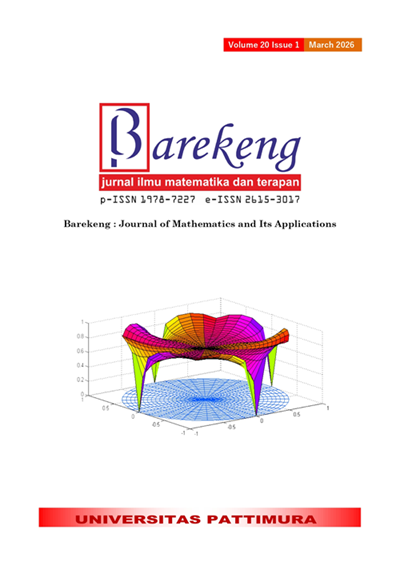VISUALIZING AND CLUSTERING FAKE JOB POSTINGS: DATA-DRIVEN INSIGHTS FOR FRAUD DETECTION
Abstract
Online job platforms have made it easier to find jobs, but they have also made it easier for scammers to post fake job postings, posing risks to job seekers. These fraudulent activities can lead to severe consequences, such as identity theft, financial loss, and emotional distress for victims. To improve recruitment platform security and safeguard users, it is essential to spot trends in these fake job postings. This study focuses on visualizing patterns within fake job postings through data-driven insights, employing various data visualization techniques to reveal key attributes associated with fraudulent activity. A dataset contains both legitimate and fraudulent job postings. Exploratory data analysis (EDA) is conducted to examine variables including salary category, job function, industry, location, and other related features by using categorical distribution, geographical distribution, and word cloud. This study provides insights for recruitment platform controllers, raises user awareness, and facilitates the early detection of fraudulent job posts by displaying clear and actionable visual patterns. The results highlight how visualization and clustering are used to gain insight into characteristics of fraudulent job postings, like the fraudulent job postings predominantly target customer-facing roles in industries like Oil & Energy and Customer Service, which are concentrated in the United States (especially Texas and California), and rely on vague language and unrealistic promises. These findings contribute to more targeted fraud detection strategies and create safer online job search environments.
Downloads
References
Federal Trade Commission, “AMERICANS LOSE $450 MILLION TO FAKE JOB SCAMS.”, Newsweek, Apr. 30, 2024. [Online]. Available: https://www.newsweek.com/americans-lose-450-million-fake-job-scams-1895739 [Accessed: 7 December 2024]
C. Reinicke, “JOB SCAMS HAVE INCREASED AS COVID-19 PUT MILLIONS OF AMERICANS OUT OF WORK. HERE’S HOW TO AVOID ONE.”, CNBC, Oct. 6, 2020. [Online]. Available: https://www.cnbc.com/2020/10/06/job-scams-have-increased-during-the-covid-19-crisis-how-to-one.html [Accessed: 7 December 2024]
PTI, “JOB SCAMS ARE ON THE RISE. WHAT ARE THEY, AND HOW CAN YOU PROTECT YOURSELF?” ETHRWorld.com. May 3, 2024. [Online]. Available: https://hrsea.economictimes.indiatimes.com/news/job-scams-are-on-the-rise-what-are-they-and-how-can-you-protect-yourself/109780955#:~:text=on%20the%20rise.-,What%20are%20they%2C%20and%20how%20can%20you%20protect%20yourself%3F,compared%20to%20the%20year%20before. [Accessed: 8 December 2024]
A. J. Ravenelle, E. Janko, and K. C. Kowalski, “GOOD JOBS, SCAM JOBS: DETECTING, NORMALIZING, AND INTERNALIZING ONLINE JOB SCAMS DURING THE COVID-19 PANDEMIC.” new media & society, vol. 24, no. 7, 1591-1610, Jul. 2022. doi: https://doi.org/10.1177/14614448221099223
A. Kurtuy, “5+ COMMON JOB SCAMS IN 2024 [& HOW TO AVOID THEM!].”, Novorésumé, Dec. 27, 2023. [Online]. Available: https://novoresume.com/career-blog/job-scams
Australian Government National Anti-Scam Centre, “WARNING ISSUED ON SOCIAL MEDIA SCAMS, AS CRACKDOWN ON FAKE JOB LISTINGS CONTINUES.” National Anti-Scam Centre, Dec. 9, 2024. [Online]. Available: https://www.nasc.gov.au/news/warning-issued-on-social-media-scams-as-crackdown-on-fake-job-listings-continues
FMT Reporters, “JOB SCAM VICTIM FORCED TO PAY RM30,000 TO RETURN TO MALAYSIA.” Free Malaysia Today, Feb. 9, 2024. [Online]. Available: https://www.freemalaysiatoday.com/category/nation/2024/02/09/job-scam-victim-forced-to-pay-rm30000-to-return-to-malaysia/
D. Salampasis, “JOB SCAMS ARE ON THE RISE. WHAT ARE THEY, AND HOW CAN YOU PROTECT YOURSELF?.” The Conversation, May 1, 2024. [Online]. Available: https://theconversation.com/job-scams-are-on-the-risewhat-are-they-and-how-can-you-protect-yourself-228996
P. Foran, “‘IT WAS ALL MY SAVINGS’: ONTARIO WOMAN LOSES $15K TO FAKE WALMART JOB SCAM.”, Toronto, Apr. 19, 2024. [Online]. Available: https://toronto.ctvnews.ca/ontario-woman-loses-15-000-to-fake-walmart-job-scam-1.6853204#:~:text=According%20to%20the%20Canadian%20Anti,to%20employment%20scams%20in%202023
CNA, “MALAYSIA ARRESTS 5 PEOPLE LINKED TO JOB SCAM SYNDICATE TARGETING SINGAPOREANS.” CNA. Mar. 27, 2024. [Online]. Available: https://www.channelnewsasia.com/asia/malaysia-arrests-suspects-jobscam-syndicate-4225336
SBS News, “EMPLOYMENT SCAMS ARE ON THE RISE. HERE’S WHAT TO LOOK OUT FOR.”, SBS News, Oct. 23, 2023. [Online]. Available: https://www.sbs.com.au/news/article/employment-scams-are-on-the-rise-hereswhat-to-look-out-for/2xgyuapu0
ET Online, “JOB SCAMS: WHO IS VULNERABLE? HOW TO PROTECT YOURSELF FROM JOB SCAMS? - job scams on the rise.” The Economic Times, May 3, 2024. [Online]. Available: https://economictimes.indiatimes.com/jobs/hr-policies-trends/job-scams-who-is-vulnerable-how-to-protect-yourself-from-job-scams/job-scams-on-the-rise/slideshow/109816792.cms?from=mdr
A. Dutta, “ENSEMBLE CLASSIFIER: DATA MINING.”, GeeksforGeeks, Jan. 10, 2022. [Online]. Available: https://www.geeksforgeeks.org/ensemble-classifier-data-mining/
F. H. A. Shibly, S. Uzzal, and H. M. M. Naleer, “PERFORMANCE COMPARISON OF TWO CLASS BOOSTED DECISION TREE AND TWO CLASS DECISION FOREST ALGORITHMS IN PREDICTING FAKE JOB POSTINGS.”, Annals of the Romanian Society for Cell Biology, vol. 25, no. 4, pp. 2462 – 2472, Apr. 2021. http://ir.lib.seu.ac.lk/handle/123456789/5611
Z. Ullah and M. Jamjoom, “A SMART SECURED FRAMEWORK FOR DETECTING AND AVERTING ONLINE RECRUITMENT FRAUD USING ENSEMBLE MACHINE LEARNING TECHNIQUES.” PeerJ Computer Science, vol. 9, p. e1234, Feb. 2023. doi: https://doi.org/10.7717/peerj-cs.1234
D. Choudhury and T. Acharjee, “A NOVEL APPROACH TO FAKE NEWS DETECTION IN SOCIAL NETWORKS USING GENETIC ALGORITHM APPLYING MACHINE LEARNING CLASSIFIERS.”, Multimedia Tools and Applications, vol. 82, no. 6, pp. 9029-9045, Mar. 2023. doi: https://doi.org/10.1007/s11042-022-12788-1
R. Rofik, R. A. Hakim, J. Unjung, B. Prasetiyo, and M. A. Muslim, “OPTIMIZATION OF SVM AND GRADIENT BOOSTING MODELS USING GRIDSEARCHCV IN DETECTING FAKE JOB POSTINGS.”, MATRIK : Jurnal Manajemen, Teknik Informatika Dan Rekayasa Komputer, vol. 23, no. 2, pp. 419-430. 2024. doi: https://doi.org/10.30812/matrik.v23i2.3566
D. Ranparia, S. Kumari, and A. Sahani, “FAKE JOB PREDICTION USING SEQUENTIAL NETWORK.”, in Proc. IEEE 15th Int. Conf. Industrial and Information Systems (ICIIS), Nov. 2020, pp. 339–343. doi: https://doi.org/10.1109/ICIIS51140.2020.9342738
C. S. Anita, P. Nagarajan, G. A. Sairam, P. Ganesh, and G. Deepakkumar, “FAKE JOB DETECTION AND ANALYSIS USING MACHINE LEARNING AND DEEP LEARNING ALGORITHMS.” Revista Geintec-Gestao Inovacao e Tecnologias, vol. 11, no. 2, pp. 642–650, Jun. 2021. https://doi.org/10.47059/revistageintec.v11i2.1701
A. Kumar., “SELF-ATTENTION GRU NETWORKS FOR FAKE JOB CLASSIFICATION.”, International Journal of Innovative Science and Research Technology, vol. 6, no. 11, Nov. 2021. [Online]. Available: https://ijisrt.com/assets/upload/files/IJISRT21NOV109.pdf
N. Goyal, N. Sachdeva, and P. Kumaraguru, “SPY THE LIE: FRAUDULENT JOBS DETECTION IN RECRUITMENT DOMAIN USING KNOWLEDGE GRAPHS.”, in Knowledge Science, Engineering and Management (KSEM 2021), Tokyo, Japan, Aug. 2021, pp. 612–623. https://doi.org/10.1007/978-3-030-82147-0_50
Y. V. Reddy, B. S. Neeraj, K. P. Reddy, and P. B. Reddy, “ONLINE FAKE JOB ADVERT DETECTION APPLICATION USING MACHINE LEARNING.” Journal of Engineering Sciences, vol. 14, no. 3, pp. 310–320, Apr. 2022. doi: https://doi.org/10.1109/DELCON54057.2022.9752784
ZipRecruiter, “SALARY: USD UNITED STATES,” ZipRecruiter, Sep. 2024. [Online]. Available: https://www.ziprecruiter.com/Salaries/Usd-Salary
Copyright (c) 2025 Chee Keong Ch’ng, Xiang Yi Wong

This work is licensed under a Creative Commons Attribution-ShareAlike 4.0 International License.
Authors who publish with this Journal agree to the following terms:
- Author retain copyright and grant the journal right of first publication with the work simultaneously licensed under a creative commons attribution license that allow others to share the work within an acknowledgement of the work’s authorship and initial publication of this journal.
- Authors are able to enter into separate, additional contractual arrangement for the non-exclusive distribution of the journal’s published version of the work (e.g. acknowledgement of its initial publication in this journal).
- Authors are permitted and encouraged to post their work online (e.g. in institutional repositories or on their websites) prior to and during the submission process, as it can lead to productive exchanges, as well as earlier and greater citation of published works.






1.gif)



